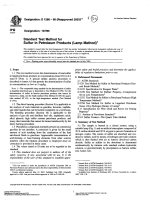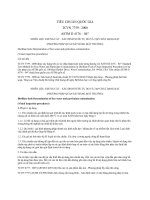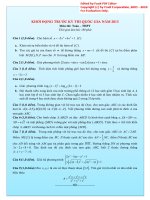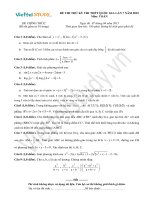Astm d 573 04 (2015)
Bạn đang xem bản rút gọn của tài liệu. Xem và tải ngay bản đầy đủ của tài liệu tại đây (99.61 KB, 6 trang )
Designation: D573 − 04 (Reapproved 2015)
Standard Test Method for
Rubber—Deterioration in an Air Oven1
This standard is issued under the fixed designation D573; the number immediately following the designation indicates the year of
original adoption or, in the case of revision, the year of last revision. A number in parentheses indicates the year of last reapproval. A
superscript epsilon (´) indicates an editorial change since the last revision or reapproval.
This standard has been approved for use by agencies of the U.S. Department of Defense.
D3184 Practice for Rubber—Evaluation of NR (Natural
Rubber)
D3185 Test Methods for Rubber—Evaluation of SBR
(Styrene-Butadiene Rubber) Including Mixtures With Oil
D4483 Practice for Evaluating Precision for Test Method
Standards in the Rubber and Carbon Black Manufacturing
Industries
E145 Specification for Gravity-Convection and ForcedVentilation Ovens
1. Scope
1.1 This test method covers a procedure to determine the
influence of elevated temperature on the physical properties of
vulcanized rubber. The results of this test method may not give
an exact correlation with service performance since performance conditions vary widely. This test method may, however,
be used to evaluate rubber compounds on a laboratory comparison basis.
1.2 The values stated in SI units are to be regarded as the
standard. The values given in parentheses are for information
only.
1.3 This standard does not purport to address all of the
safety concerns, if any, associated with its use. It is the
responsibility of the user of this standard to establish appropriate safety and health practices and determine the applicability of regulatory limitations prior to use. (For specific
precautionary statement, see Note 1.)
3. Summary of Test Method
3.1 Specimens of vulcanized rubber are exposed to the
deteriorating influence of air at specified elevated temperatures
for known periods of time, after which their physical properties
are determined. These are compared with the properties determined on the original specimens and the changes noted.
3.2 Unless otherwise specified, the determination of the
physical properties shall be carried out in accordance with Test
Methods D412.
2. Referenced Documents
3.3 Except as may be otherwise specified in this test
method, the requirements of Practices D3182 and D3183 shall
be complied with and are made part of this test method.
2.1 ASTM Standards:2
D15 Method of Compound and Sample Preparation for
Physical Testing of Rubber Products (Withdrawn 1975)3
D412 Test Methods for Vulcanized Rubber and Thermoplastic Elastomers—Tension
D1349 Practice for Rubber—Standard Conditions for Testing
D3182 Practice for Rubber—Materials, Equipment, and Procedures for Mixing Standard Compounds and Preparing
Standard Vulcanized Sheets
D3183 Practice for Rubber—Preparation of Pieces for Test
Purposes from Products
3.4 In case of conflict between the provisions of this test
method and those of detailed specifications or test methods for
a particular material, the latter shall take precedence.
4. Significance and Use
4.1 Rubber and rubber products must resist the deterioration
of physical properties with time caused by oxidative and
thermal aging. This test method provides a way to assess these
performance characteristics of rubber, under certain accelerated conditions as specified.
4.2 Please refer to Annex A1 for important information on
standard compounds used for precision testing for accelerated
test aging evaluation.
1
This test method is under the jurisdiction of ASTM Committee D11 on Rubber
and is the direct responsibility of Subcommittee D11.15 on Degradation Tests.
Current edition approved July 1, 2015. Published October 2015. Originally
approved in 1940. Last previous edition approved in 2010 as D573 – 04 (2010).
DOI: 10.1520/D0573-04R15.
2
For referenced ASTM standards, visit the ASTM website, www.astm.org, or
contact ASTM Customer Service at For Annual Book of ASTM
Standards volume information, refer to the standard’s Document Summary page on
the ASTM website.
3
The last approved version of this historical standard is referenced on
www.astm.org.
5. Apparatus
5.1 Type IIB ovens specified in Test Method E145 are
satisfactory for use through 70°C. For higher temperatures,
Type IIA ovens are necessary.
5.1.1 The interior size shall be as follows or of an equivalent
volume:
Copyright © ASTM International, 100 Barr Harbor Drive, PO Box C700, West Conshohocken, PA 19428-2959. United States
1
D573 − 04 (2015)
Interior size of air oven:
min
max
7.2 The cross-sectional dimensions of test specimens for
calculating the physical properties shall be measured prior to
exposure in the aging chamber. Gage lines used for measuring
elongation shall be applied after the specimens have been aged.
Only specimens of similar dimensions having approximately
the same exposed areas may be compared with each other.
300 by 300 by 300 mm (12 by 12 by 12 in.)
900 by 900 by 1200 mm (36 by 36 by 48 in.)
5.1.2 Provision shall be made for suspending specimens
vertically without touching each other or the sides of the aging
chamber.
5.1.3 The heating medium for the aging chamber shall be air
circulated within it at atmospheric pressure.
5.1.4 The source of heat is optional but shall be located in
the air supply outside of the aging chamber proper.
5.1.5 The temperature should be automatically recorded
over the entire test period using a temperature-measuring
device capable of measuring at the specified temperature to
within 61°C. Located in the upper central portion of the
chamber near the center of the aging specimens. For apparatus
not equipped with automatic recording capabilities, temperature shall be measured with sufficient frequency to ascertain
that the temperature limits specified in 10.2 are adhered to.
5.1.6 Automatic temperature control by means of thermostatic regulation shall be used.
5.1.7 The following special precautions shall be taken in
order that accurate, uniform heating is obtained in all parts of
the aging chamber:
5.1.7.1 The heated air shall be thoroughly circulated in the
oven by means of mechanical agitation. When a motor-driven
fan is used, the air must not come in contact with the fan motor
brush discharge because of danger of ozone formation.
5.1.7.2 Baffles shall be used as required to prevent local
overheating and dead spots.
5.1.7.3 The thermostatic control device shall be so located
as to give accurate temperature control of the heating medium.
The preferred location is adjacent to the recording thermometer.
5.1.7.4 An actual check shall be made by means of maximum reading thermometers placed in various parts of the oven
to verify the uniformity of the heating.
8. Number of Test Specimens
8.1 At least three test specimens shall be used to determine
the original physical properties of each sample and also three
or more specimens of the same material for each exposure
period of the test.
8.2 When minimum requirements are specified, one test
shall be made for tensile strength and elongation. If the results
are below the specified requirements, two additional specimens
shall be prepared from the original sample and tested. Should
the results of either of these tests be below the specified
requirements, the samples shall be considered to have failed to
meet the specifications.
9. Tests of Unaged Specimens
9.1 The stress-strain properties or tensile strength and ultimate elongation and any other required properties of the
original unaged specimens shall be determined within 96 h of
the start of the aging period. Results on specimens that are
found to be imperfect shall be discarded and retests shall be
made.
9.2 When rubber compounds are to be tested for the purpose
of determining compliance with specifications, it shall be
permissible to determine the original properties required in 9.1
simultaneously with the determination of the values after the
first aging period even though the elapsed time exceeds 96 h.
10. Procedure for Accelerated Aging
10.1 Place the specimens for aging in the oven after it has
been preheated to the operating temperature. If possible, avoid
simultaneous aging of a mixed group of different compounds.
For instance, high-sulfur compounds should not be aged with
low-sulfur compounds and those containing antioxidants shall
not be aged with those having no antioxidants. Some migration
is known to occur.
6. Sampling
6.1 The sample size shall be sufficient to allow for the
determination of the original properties on three specimens and
also on three or more specimens for each exposure period of
the test. At least 24 h must elapse between completion of the
vulcanization of the samples and the start of the aging test.
10.2 The operating temperature may be any elevated standard temperature as shown in Practice D1349, as agreed upon.
6.2 When minimum requirements are specified, one test on
three dumbbells shall be considered sufficient. But if the results
are below the specified requirements, two additional specimens
shall be prepared from the original sample and tested. Should
the results of either of these tests be below the specified
requirements, the sample shall be considered to have failed to
meet the specifications.
NOTE 1—Caution: It should be noted that, for each 10°C increase in
temperature, the rate of oxidation may be approximately double. With
rapid aging types of rubber or those containing or contaminated by certain
oxidizing chemicals, the rate of oxidation may be catalyzed to such an
extent as to become violent with increasing temperatures.
10.3 Start the aging interval at the time the specimens are
placed in the oven and continue for a measured time interval.
The selection of suitable intervals of aging will depend on the
rate of deterioration of the particular material being tested.
Intervals frequently used are 3, 7, and 14 days.
7. Test Specimens
7.1 Dumbbell-shaped specimens prepared as described in
Test Methods D412 shall be considered standard. Their form
shall be such that no mechanical, chemical, or heat treatment
will be required after exposure. If any adjustments (for
example, to thickness) are necessary, they should be performed
prior to exposure.
10.4 Use aging intervals such that the deterioration will not
be so great as to prevent determination of the final physical
properties. In experimental work, it is desirable to use a range
2
D573 − 04 (2015)
TABLE 1 Type 2 Precision Results—100°C Aging
of periods, while for routine tests of known materials, fewer
intervals may be employed.
Part 1—Percent Tensile Strength Change, 48 h
10.5 At the termination of the aging interval, remove the
specimens from the oven, cool to room temperature on a flat
surface, and allow them to rest not less than 16 h nor more than
96 h before determination of the physical properties. Apply the
gage lines to the specimens for use in measuring elongations.
Material or
Compound
NR (1G)
SBR (9B)
NBR (1F)
CR (2D)
OESBR (10B3)
IIR (2E)
Pooled Values
11. Physical Tests of Aged Specimens
11.1 The tensile strength and ultimate elongation or the
stress-strain properties of the specimens aged for different
intervals shall be determined as the intervals terminate in the
progress of aging, disregarding the fact that more specimens
may still be aging. In determining the physical properties after
aging, the final values shall be the median of results from three
specimens except that under the following conditions two
additional specimens shall be exposed and tested and the
median of the values for the five specimens shall be used:
11.1.1 If one or more values do not meet the specified
requirements when testing for compliance with specifications.
11.1.2 If referee tests are being made. After completion of
the tests, the broken specimens shall be examined visually and
manually and their condition noted.
−56.6
−14.2
−11.5
−10.6
−7.6
−1.1
...
Within
Laboratories
Sr
r
3.28
9.28
3.42
9.68
2.46
6.96
3.83
10.8
2.34
6.62
3.47
9.82
3.18
9.00
Between
Laboratories
SR
R
5.91
16.7
3.02
8.55
2.49
7.05
5.11
14.5
5.56
15.7
3.77
10.7
3.90
11.04
Part 2—Percent Change in Elongation, Average of 48, 96 h Aging
NR (1G)
SBR (9B)
OESBR (10B3)
NBR (1F)
CR (2D)
IIR (2E)
Pooled Values
−55.6
−48.3
−40.5
−39.6
−12.1
−6.2
...
5.08
5.38
3.20
7.10
7.85
2.56
5.20
14.4
15.2
9.06
20.1
22.2
7.24
14.7
7.79
6.09
5.11
7.11
9.00
3.97
6.51
22.0
17.2
14.5
20.1
25.5
11.2
18.4
NOTE 1—The averaging of results for 48 and 96 h of aging gives an
increased DF estimate of precision.
NOTE 2—
Sr = within laboratory standard deviation
r = repeatability (in measurement units)
(r) = repeatability (in percent)
SR = between laboratory standard deviation
R = reproducibility (in measurement units)
(R) = reproducibility (in percent)
12. Calculation
12.1 Express the results of the aging test as a percentage of
the change in each physical property (tensile strength, ultimate
elongation, or tensile stress), calculated as follows:
P 5 @ ~ A 2 O ! /O # 3 100
Mean Test
Level
14.2 A Type 2 (interlaboratory) precision was evaluated in
1974. Both repeatability and reproducibility are short term, a
period of a few days separates replicate test results. A test result
is expressed on the basis of a median value, as specified by Test
Methods D412 obtained on three determinations or measurements of the property or parameter in question.
(1)
where:
P = percentage change in property,
O = original value, and
A = value after aging.
14.3 Six different materials were used in the interlaboratory
program, these were tested in three laboratories on two
different days. These precision results were obtained for a
variety of compounds prepared in accordance with Methods
D15 prior to its removal from the Annual Book of ASTM
Standards. Please see Annex A1 for more details on this work.
13. Report
13.1 Report the following information:
13.1.1 The results calculated in accordance with Section 12,
13.1.2 All observed and recorded data on which the calculations are based,
13.1.3 Type of aging test,
13.1.4 Aging interval,
13.1.5 Aging temperature,
13.1.6 Duration, temperature, and data of vulcanization of
the rubber, if known,
13.1.7 Dates of original and final determinations of physical
properties, and
13.1.8 Dimensions of test specimens.
14.4 The results of the precision calculations for repeatability and reproducibility for both percent tensile strength change
and percent elongation change are given in Table 1, in
ascending order of material average or level, for each of the
materials evaluated.
14.4.1 The precision of this test method may be expressed in
the format of the following statements that use an appropriate
value of r, R, (r), or (R), that is, that value to be used in
decisions about test results (obtained with the test method).
The appropriate value is that value of r or R associated with a
mean level in the precision tables closest to the mean level
under consideration at any given time, for any given material in
routine testing operation.
14. Precision and Bias4
14.1 This precision and bias section has been prepared in
accordance with Practice D4483. Refer to this practice for
terminology and other statistical calculation details.
14.5 Repeatability—The repeatability, r, of this test method
has been established as the appropriate value tabulated in the
precision tables. Two single test results, obtained under normal
test method procedures, that differ by more than this tabulated
4
Supporting data have been filed at ASTM International Headquarters and may
be obtained by requesting Research Report RR:D11-1056.
3
D573 − 04 (2015)
r (for any given level) must be considered as derived from
different or non-identical sample populations.
percent elongation or percent tensile strength change. No
values are given for (r) or (R) because of the near zero average
values for some of the materials.
14.6 Reproducibility—The reproducibility, R, of this test
method has been established as the appropriate value tabulated
in the precision tables. Two single test results obtained in two
different laboratories, under normal test method procedures,
that differ by more than the tabulated R (for any given level)
must be considered to have come from different or nonidentical sample populations.
14.8 Bias—In test method terminology, bias is the difference
between an average test value and the reference (or true) test
property value. Reference values do not exist for this test
method since the value (of the test property) is exclusively
defined by the test method. Bias, therefore, cannot be determined.
14.7 The precision results indicate that the repeatability and
reproducibility of both percent tensile strength change and
percent elongation change are essentially the same. Also the
value of r or R, or both, does not vary with the magnitude of
15. Keywords
15.1 accelerated aging; elevated temperature; oxidative aging; rubber articles; rubber products; thermal aging
ANNEX
(Mandatory Information)
A1. FORMER TEST METHOD (D15) COMPOUNDS USED FOR PRECISION TESTING
A1.1 Introduction
A1.3 Materials and Mixing
A1.1.1 Testing to develop precision data was begun by
some Subcommittees in D11 prior to the removal of Methods
D15, Compound and Sample Preparation for Physical Testing
of Rubber Products. In this initial precision work, some of the
standard compounds that were currently included in Methods
D15 were used. Since that time, these standard Methods D15
compounds have been either modified or removed from the
Annual Book of ASTM Standards. They were replaced by a
series of new standards, for example, Test Methods D3184 on
NR, Test Methods D3185 on SBR, and so forth.
A1.3.1 In the precision test programs that generated Type 2
Precision data for D11.15 standards, that is, that precision
which includes compound weighing, mixing, and curing components of variation, a special testing procedure was employed.
A common supply was set up for all the materials needed to
prepare compounds in accordance with the tables of this
Annex. All laboratories that participated in any interlaboratory
program drew their materials from this common uniform
supply; thus the within-materials source of variation was
reduced to the lowest possible (practical) level.
A1.1.2 To provide a source of reference for the compounds
removed from Methods D15, those compounds used in measuring precision, especially those used in Subcommittee
D11.15, are included in Tables A1.1-A1.6 taken directly from
Methods D15. These tables are listed below.
A1.3.2 Mixes of the selected compounds were made on
specified days (2 days normally being selected) to determine
within-laboratory variability as specified in Practice D4483.
A1.1.3 The formulations for the compounds in Tables
A1.1-A1.6 are placed in this test method temporarily. This test
method is selected as a location since it is the most frequently
used standard test for evaluating compounds for accelerated
aging performance.
TABLE A1.1 Type A—Standard Formulations for StyreneButadiene Rubbers
NBS
A1.2 Cure Times for Compounds
SBR or OE-SBR
Zinc oxide
Stearic acid
Sulfur
Furnace blackA
TBBS
A1.2.1 The cure times for compounds selected in the
D11.15 precision testing are as follows:
Compound
Polychloroprene (neoprene)
Natural (1G)
SBR (9B)
OE–SBR (10B3)
Butyl (2E)
NBR (1F)
Time,
min,
30
30
50
50
80
40
Temperature,° C
150
145
145
145
150
150
Batch factor
A
370
372
371
378
384
9B
100.00
3.00
1.00
1.75
50.00
1.00
156.75
3.0
Current Industry Reference Black (IRB) may be used in place of NBS 378,
although slightly different results may be obtained. Weigh ingredients to nearest
0.1 g for SBR and carbon black and to the nearest 0.01 g for other ingredients.
4
D573 − 04 (2015)
TABLE A1.2 Type A—Standard Formulations for Styrene-Butadiene Rubber Compounds (expressed on 100 Part Rubber Basis)
Material
SBR
OE-SBR
Zinc oxide
Stearic acid
Sulfur
Furnace blackA
TBBS
A
NBS
370
372
371
378
384
10B1 Non-OE
Rubbers
10B2 25-Oil
Rubbers
10B3 37.5-Oil
Rubbers
10B4 50-Oil
Rubbers
10B5 62.5-Oil
Rubbers
10B6 75-Oil
Rubbers
100.00
...
125.00
3.75
1.25
2.19
62.50
1.25
195.94
...
137.50
4.12
1.38
2.42
68.75
1.38
215.55
...
150.00
4.50
1.50
2.63
75.00
1.50
235.13
...
162.50
4.88
1.63
2.85
81.25
1.63
254.74
...
175.00
5.25
1.75
3.06
87.50
1.75
274.31
3.00
1.00
1.75
50.00
1.00
156.75
Current Industry Reference Black (IRB) may be used in place of NBS 378, although slightly different results may be obtained.
TABLE A1.4 Standard Formulas for Butyl Rubber CompoundsA
TABLE A1.3 Standard Formulas for Neoprene Rubber
CompoundsA
Material
NBS Standard
Sample No.
Neoprene W
Magnesium oxide
Stearic acid
SRF carbon black
Zinc oxide
2-Mercaptoimidazoline
Phenyl beta naphthylamine
Specific gravity (calculated)
A
...
376
372
382
370
...
377
ID
2D
100
4
0.5
...
5
0.35
2
1.29
100
4
1
29
5
0.5
2
1.39
Material
Butyl rubber
Zinc oxide
Sulfur
Stearic acid
Benzothiazyl disulfide
Tetramethyl thiuram-disulfide
Channel black
Oil furnace black (HAF type)
Specific gravity (calculated)
A
NBS Standard
Sample No.
388
370
371
372
373
374
375
378B
IE
2E
3E
100
5
2
...
...
1
...
...
0.97
100
5
2
3
0.5
1
50
...
1.12
100
3
1.75
1
...
1
...
50
1.13
For mill mixing, use 2 × recipe weight.
IRB or Industry Reference Black may be used as a suitable alternative, but the
same results may not be obtained.
For mill mixing, use 3 × recipe weight.
B
5
D573 − 04 (2015)
TABLE A1.5 Standard Formula for Testing Carbon Black
NBS Standard
Sample No.
Material
A
...
372
370
373
371
...
Natural rubber
Stearic acid
Zinc oxide
Benzothiazyl disulfide
Sulfur
Carbon black
Specific gravity (calculated)
IG
100.00
3.00
5.00
0.60
2.50
50.00B
1.13
A
Available from the Firestone Tire and Rubber Co. Specially selected Liberian
crepe with 600 % modulus of 700 ± 100 psi when tested in compound 1A.
B
For all carbon blacks except FT and MT. For those blacks where 75 parts are
used, the calculated specific gravity is 1.19.
TABLE A1.6 Standard Formulas for Nitrile Rubber Compound
NBS Standard
Sample No.
Material
Nitrile rubber
Zinc oxide
Sulfur
Stearic acid
Benzothiazyl disulfide
Gas furnace black
Specific gravity (calculated)
391
370
371
372
373
382
IF
100
5
1.5
1
1
40
1.18
ASTM International takes no position respecting the validity of any patent rights asserted in connection with any item mentioned
in this standard. Users of this standard are expressly advised that determination of the validity of any such patent rights, and the risk
of infringement of such rights, are entirely their own responsibility.
This standard is subject to revision at any time by the responsible technical committee and must be reviewed every five years and
if not revised, either reapproved or withdrawn. Your comments are invited either for revision of this standard or for additional standards
and should be addressed to ASTM International Headquarters. Your comments will receive careful consideration at a meeting of the
responsible technical committee, which you may attend. If you feel that your comments have not received a fair hearing you should
make your views known to the ASTM Committee on Standards, at the address shown below.
This standard is copyrighted by ASTM International, 100 Barr Harbor Drive, PO Box C700, West Conshohocken, PA 19428-2959,
United States. Individual reprints (single or multiple copies) of this standard may be obtained by contacting ASTM at the above
address or at 610-832-9585 (phone), 610-832-9555 (fax), or (e-mail); or through the ASTM website
(www.astm.org). Permission rights to photocopy the standard may also be secured from the Copyright Clearance Center, 222
Rosewood Drive, Danvers, MA 01923, Tel: (978) 646-2600; />
6









